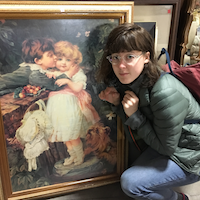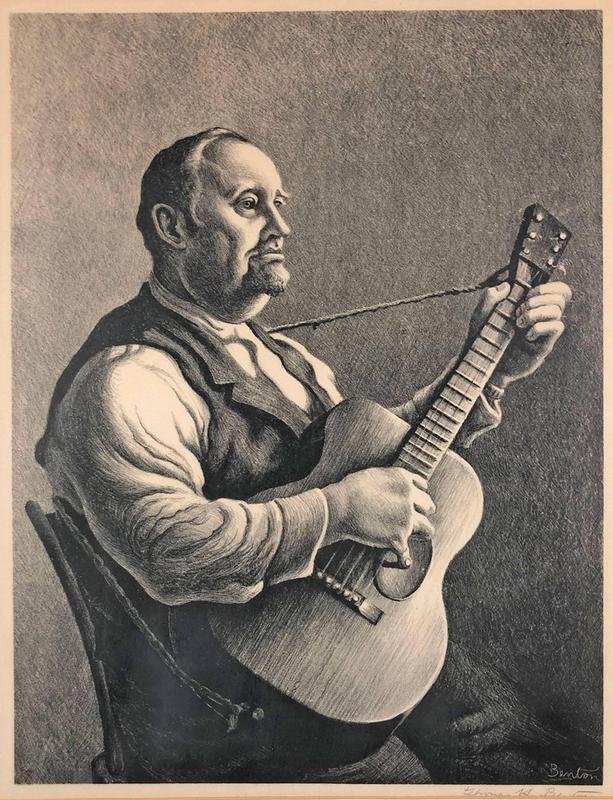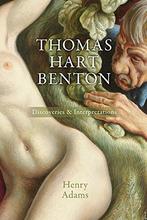More about Burl Ives
- All
- Info
- Shop

Contributor
Thomas Hart Benton liked painting folk musicians, like Burl Ives, almost as much as he liked playing music himself. Which is to say, a lot.
It’s actually hard to look at burly Thomas Hart Benton and not get the “harmonicist in a traveling folk band” vibe. In fact, Benton was really good at a lot of things. You’d be hard-pressed to determine whether he was partial to music or art, but it’s not as if he had to choose. As a muralist, Thomas Hart Benton traveled around the United States painting and schmoozing with the great artists and musicians of the time. He preferred to give his artwork room to breath, opting to keep it outside of museums whenever possible. It’s perhaps for this reason that his name gets lost in the history books, overshadowed by associates like Diego Rivera and Jackson Pollock, who catapulted into megastardom
Thomas Hart Benton is often considered a quintessential Regionalist painter, along with Grant Wood and John Steuart Curry, and a representative of the popular American experience due to his Midwestern upbringing. In reality, he grew up in a family of wealthy politicians before leaving the Midwest to spend twenty years living in New York with a long stint in Paris to study art. Burl Ives himself said that, “...he liked to be one of the gang, but he wasn’t. He was an introspective, thinking man...but he didn’t want anybody to know it. Tom Benton was an aristocrat.” Seems like a pretty big burn coming from someone that Benton basically idolized. Ives, conversely, grew up on a poor family farm and spent his life as a traveling musician in the USA and Mexico.
Like many city-dwellers who eventually become overwhelmed by the high price of living, Benton decided to move to the island of Martha’s Vineyard after a New York friend told him that it was possible to rent a lobsterman’s shack for ten dollars a month. Benton’s politically charged artwork often speaks out against fascism, capitalism, and racism, however it was on the island that a slightly calmer subject captivated his attention: music—he listened to it, played it, archived it, and often created artwork featuring his favorite musicians, as he’s done here with Burl Ives.
The summers that he spent on Martha’s Vineyard hobnobbing with musicians were apparently some of the happiest in his life. He lived in the city of Chilmark in a house—a sort of co-op meets summer camp—with other intellectuals of the day including Roger Baldwin, founder of the ACLU. He was a virtuoso harmonica player (after discovering it through his son who was, fittingly, a gifted flute-player) and performed with harmonica bands in New York, Martha’s Vineyard and Kansas City, even forming a group of his own that he hilariously dubbed Tom Benton and His Harmonica Boys (I still haven’t gotten over how funny this name is). The band included his wife Rita, an Italian pianist and guitarist, as well as visiting art students and other “country folk.” In 1941, he released one of a three-record album deal under England’s Decca Records called Saturday Night at Tom Benton’s, for which he designed the album cover and informational brochure.
When he wasn't entrenched in this Bob Dylan-esque, harmonica-wielding, traveling musician phase, he analyzed and studied music theory. Benton possessed a humongous record collection and spent a great deal of time transcribing of British traditional folk songs (around 128 pieces). He neatly copied folk songs with piano accompaniment and numbers for each melodic pitch in order to get the right hole on his harmonica. Benton firmly believed that the essence of America was inherent in the folk music of the hills and valleys of south-central USA. Fearing that these traditions were in danger of becoming commercialized he set out to wander the backcountry transcribing music and sketching performers. His documentation has been an essential resource for musicologists today.
Despite Benton’s bourgeois upbringing, he still had quite a bit in common with Burl Ives. Both were inspired to wander around Depression-era America spreading their artistic vision, Ives collecting folk songs and Benton making sketches; both were influenced by their Midwestern upbringing, while still spending a lot of time in urban New York City; and both broke with early associates over political differences. They obviously enjoyed each other’s company, although Ives once almost lost his nose to Benton’s teeth during a drunken brawl. Even the best of friends have their quarrels.
Sources
- Mazow, Leo G. Thomas Hart Benton and the American Sound. Pennsylvania: Pennsylvania State University, 2012.
- Khalid, Farisa. "Thomas Hart Benton". The New York Times. https://www.nytimes.com/2012/07/22/books/review/thomas-hart-benton.html (accessed 17 July 2018).
- Debenedette, Valerie. "15 Things You May Not Know About Thomas Hart Benton." MentalFloss. http://mentalfloss.com/article/77438/15-things-you-might-not-know-about… (accessed 17 July 2018).
- Mitgang, Herbert. "How Martha's Vineyard Influenced Benton's Art." The New York Times. https://www.nytimes.com/1981/06/23/books/how-martha-s-vineyard-influenc… (accessed 7 July 2018).
- Curcio, David. "A Regionalist in Hollywood: Thomas Hart Benton. Big Red and Shiny. http://bigredandshiny.org/20806/a-regionalist-in-hollywood-thomas-hart-… (accessed 7 July 2018).












